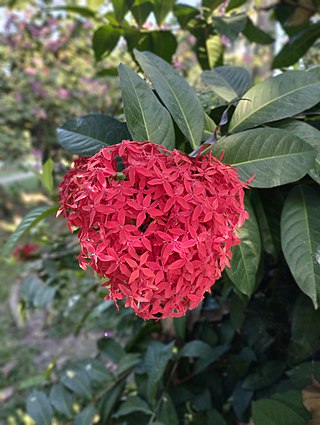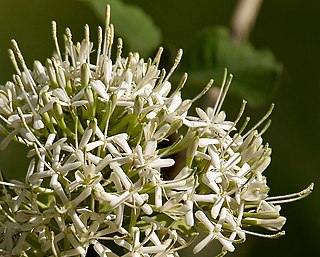
Olea is a genus of flowering plants in the family Oleaceae. It includes 12 species native to warm temperate and tropical regions of the Middle East, southern Europe, Africa, southern Asia, and Australasia. They are evergreen trees and shrubs, with small, opposite, entire leaves. The fruit is a drupe. Leaves of Olea contain trichosclereids.

Olea capensis, the black ironwood, is an African tree species in the olive family Oleaceae. It is widespread in sub-Saharan Africa: from the east in Somalia, Ethiopia and Sudan, south to the tip of South Africa, and west to Cameroon, Sierra Leone and the islands of the Gulf of Guinea, as well as Madagascar and the Comoros. It occurs in bush, littoral scrub and evergreen forest.

Psychotria is a genus of flowering plants in the family Rubiaceae. It contains 1,645 species and is therefore one of the largest genera of flowering plants. The genus has a pantropical distribution and members of the genus are small understorey trees in tropical forests. Some species are endangered or facing extinction due to deforestation, especially species of central Africa and the Pacific.

Ixora is a genus of flowering plants in the family Rubiaceae. It is the only genus in the tribe Ixoreae. It consists of tropical evergreen trees and shrubs and holds around 544 species. Though native to the tropical and subtropical areas throughout the world, its centre of diversity is in Tropical Asia. Ixora also grows commonly in subtropical climates in the United States, such as Florida where it is commonly known as West Indian jasmine.

Pavetta is a genus of flowering plants in the family Rubiaceae. It comprises about 360 species of trees, evergreen shrubs and sub-shrubs. It is found in woodlands, grasslands and thickets in sub-tropical and tropical Africa and Asia. The plants are cultivated for their simple but variable leaves, usually opposite but also occur in triple whorls. The leaves are often membranous with dark bacterial nodules. Pavetta has small, white, tubular flowers, sometimes salviform or funnel-shaped with 4 spreading petal lobes. The flowers are carried on terminal corymbs or cymes.
Lophacme is a genus of African plants in the grass family.

Amellus is a genus of flowering plants in the family Asteraceae described as a genus by Linnaeus in 1759.
Zostera capensis is a species of dwarf eelgrass growing along the shores of the Indian and Atlantic oceans on the African coast. Its range extends from southern Kenya, through Tanzania, Mozambique, Madagascar, and South Africa up to Angola. This species is the dominant seagrass species in South Africa, occurring as fragmented populations along the coast and occupying subtidal and intertidal habitats in shallow bays, estuaries and lagoons. The two largest meadows in South Africa are present in the Knysna lagoon and Berg river estuary. When last mapped in 2007, Zostera capensis cover in the Berg river estuary was estimated at 206 hectares, while in 2019 the Knysna lagoon was mapped at 316 hectares. Further north in its distribution, Maputo bay in Mozambique is an important habitat for this species, containing approximately 4016 hectares of mixed Zostera capensis and Halodule wrightii on muddy flats. Over its total distribution, this species is estimated to occupy less than 2000 km².

Pavetteae is a tribe of flowering plants in the family Rubiaceae and contains about 624 species in 9 genera. Its representatives are found from the tropics and subtropics of the Old World and the southern Pacific region.

Retzia is a genus of flowering plants in the family Stilbaceae described as a genus in 1776.
Pavetta blanda is a species of flowering plant in the family Rubiaceae, native to the Laccadive Islands, south India and Sri Lanka.
The anthophytes are a grouping of plant taxa bearing flower-like reproductive structures. They were formerly thought to be a clade comprising plants bearing flower-like structures. The group contained the angiosperms - the extant flowering plants, such as roses and grasses - as well as the Gnetales and the extinct Bennettitales.

Pavetta schumanniana, the poison bride's bush, is a species of plant described by F.Hoffm. and Karl Moritz Schumann. Pavetta schumanniana is part of the genus Pavetta and the family Rubiaceae. No subspecies are listed in the Catalog of Life.









